George, this truly great and glorious Martyr of Christ, was born of a father from Cappadocia and a mother from Palestine. Being a military tribune, or chiliarch (that is, a commander of a thousand troops), he was illustrious in battle and highly honoured for his courage. When he learned that the Emperor Diocletian was preparing a persecution of the Christians, Saint George presented himself publicly before the Emperor and denounced him. When threats and promises could not move him from his steadfast confession, he was put to unheard-of tortures, which he endured with great bravery, overcoming them by his faith and love towards Christ. By the wondrous signs that took place in his contest, he guided many to the knowledge of the truth, including Queen Alexandra, wife of Diocletian, and was finally beheaded in 296 in Nicomedia.
His sacred remains were taken by his servant from Nicomedia to Palestine, to a town called Lydda, the homeland of his mother, and then were finally transferred to the church which was raised up in his name. (The translation of the Saint’s holy relics to the church in Lydda is commemorated on November 3; Saint Alexandra the Queen, on April 21.)
The Church of the Holy Great Martyr George from Lodd, Lydda
The Church dedicated to the Great Martyr George is located in Lodd, Lydda. Lodd is one of the major cities in Palestine. Following the tradition of the ancient churches – built on the graves of the martyrs, the Church of St George was built in the place where the saint was buried after been martyred.
Lydda is an ancient city mentioned in both the Old as well as the New Testaments; In the Ist Chronicle: 8, 12, and in the Acts of the Apostles: ” As Peter traveled about the country, he went to visit the saints in Lydda. There he found a man named Aeneas, a paralytic who had been bedridden for eight years. “Aeneas,” Peter said to him, “Jesus Christ heals you. Get up and take care of your mat.” Immediately Aeneas got up. All those who lived in Lydda and Sharon saw him and turned to the Lord. “(Acts 9, 32-35). According to the Holy Scripture, Lydda was built by a member of the tribe of Benjamin, Shemed. This place was deserted starting with the captivity of Babylon, but it was reestablished immediately after the Jews returned from exile.
In the Hellenistic period, this place was situated outside the borders of Judea, but in the period of the Maccabees, it was returned to the Israeli.
.jpg)
By the Byzantine era, the town was already largely Christianized. This is one of the legendary places where the Holy Great Martyr St. George was born which is why, for a time, the city was called Georgiopolis. The Tomb of the Holy Martyr was built in the very place, where it exists today. Conquered by the Muslims in the year 636, the city of Lydda will become part of the region of Philistines. Later, in 1099, the Crusaders will occupy the city.
.jpg)
.jpg)
For the English king Richard the Lionheart, the city held a precious value, considering this was the place of birth of the protector of England – Holy Great Martyr George. For a time the Crusaders made this city the seat of the Roman rite. According to the Jewish pilgrim Benjamin of Tudela, in the city of Lydda, in the year 1170, only a Jewish dyer was left among the Crusaders inhabitants.
.jpg)
.jpg)
St. George is famous not only in his hometown but throughout the whole Christian world as one of the most beloved saints. After saint’ martyrdom, Christians have taken his body and brought it to the Holy Land in his native village. The Church St. George (el-Khader) of Lydda, is one of the most sacred places of worship in the region and it was dedicated to the Christian Martyrs of the fourth century.
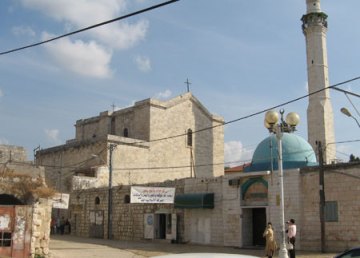
The present church from Lodd was built in 1870, and it was attached by a common wall to the mosque of Chodr El. Towards the end of the nineteenth century, the Greek Orthodox Patriarchate of Jerusalem has received approval from Turkish authorities, to rebuild a church on the site of a former Christian basilica. The last ruins present here belonged to an ancient Christian church from the XV century; the new basilica – a Greek Orthodox Monastery built over those ruins, was dedicated to the Holy Martyr George as well as to the Holy Archangels Michael and Gabriel.
.jpg)
In order to approve the building of the new Orthodox Monastery, Turkish authorities have requested that the remaining space to be given up for the mosque. Therefore, the current Church St. George occupies only the north-eastern corner of the old Christian basilica.
Above the church door’ entrance a nice icon depicts the great Martyr George slaying the dragon.
.jpg)
.jpg)
The underground chapel of this newly built Orthodox Monastery preserves the tomb of St. George and part of his relics.
.jpg)
.jpg)
The church also preserves the “chains” that bound St. George before going for his martyrdom.
.jpg)
The stone sarcophagus of St George, found in the underground chapel, was restored in 1871, during the time of Patriarch Cyril.
.jpg)
Small parts from the precious relics of St George are also present in many other churches throughout the world, one country adopted St. George as its patron Saint and it was named after the saint’ name: Georgia.

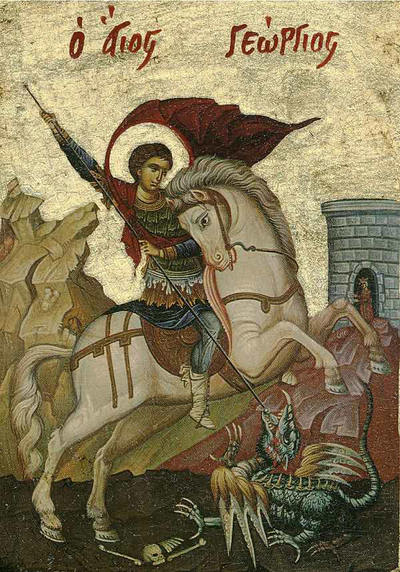
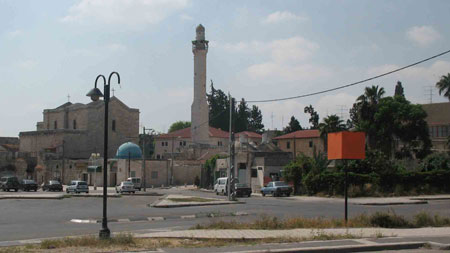
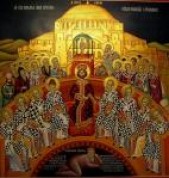 Christian Dogma
Christian Dogma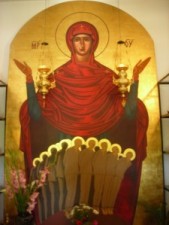 Christian Martyrs
Christian Martyrs Christian Orthodox Churches and Monasteries
Christian Orthodox Churches and Monasteries Christian Sermons and News
Christian Sermons and News Church's Teachings on Fasting
Church's Teachings on Fasting Ecumenism – a Great Heresy
Ecumenism – a Great Heresy Father George Calciu
Father George Calciu Life_a Sacred Gift form God
Life_a Sacred Gift form God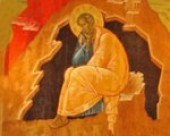 Orthodox Saints and Church Fathers
Orthodox Saints and Church Fathers Spiritual Elders
Spiritual Elders Daily Bible Readings
Daily Bible Readings Journey to Orthodoxy
Journey to Orthodoxy Listen to Ancient Faith Radio
Listen to Ancient Faith Radio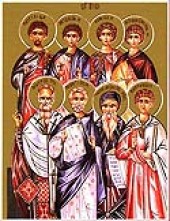 Orthodox Calendar of Feasts and Saints
Orthodox Calendar of Feasts and Saints Orthodox Christian Mission Center
Orthodox Christian Mission Center Orthodox Institute
Orthodox Institute OrthodoxChristianNetwork TV
OrthodoxChristianNetwork TV
9 comments
Comments feed for this article
October 25, 2011 at 2:26 PM
manoj chandanappally
A valuable informations about st.George
March 26, 2012 at 7:40 PM
rebelsprite
Thank you so much for this informative post. I am curious if you managed to visit here yourself? I would like to visit, but I have heard sometimes even a tour group can be turned away because the monastery may be closed.
March 27, 2012 at 8:25 PM
orthodoxword
Yes I was blessed to visit the tomb of St George many years ago and there were no restrictions. Not sure how is the situation today, you may call the Greek Patriarchate of Jerusalem, they could help you out.
Through the prayers of St George!
March 27, 2012 at 8:32 PM
rebelsprite
Thank you for the advice!
April 23, 2012 at 7:51 AM
h. s.
Thank you for this wonderful posting of info. and pictures. I was blessed in my spirit to see the tomb, chains, stone sarcoghagus, and other relics in the pictures. This moved me to pray. :)
April 23, 2012 at 12:40 PM
rebelsprite
Thanks be to God and St. George, I was able to venerate his tomb 2 weeks ago. Holy Great Martyr George, pray to God for us!
November 17, 2013 at 3:46 PM
Karin Schultze
Thank you blessed Saint for healing, cleansing, deliverance, interceding for my son’s (Erich H.) family tree (parents, grandparents, greatgrandparents), nieces/nephews/godchild’s genograms. Karin S. Thank you Blessed Saints and Martyrs for praying for us (special intercession for Katrina’s aunt whose wheelchair bound).
March 4, 2016 at 9:51 AM
very rev geevarghese cor episcopa
Thank you blessed saint for healing.Very Rev Geevarghese Cor Episcopa.Mavelikara, Kerala, India.
April 18, 2017 at 8:34 AM
madalina maria marinescu
Christ is Risen!
I thank you for the beautiful way this article is bringing to our attention, details of St George, the great Martyr and Trophy bearer, that I wasnt aware of. May I kindly ask your permission to include these details in a booklet which I would like to print out, in due time for the celebration of St George’s feast? In this booklet, I will also include a few icons and another text which presents his martyrdom and conversion of many through his great example of faith.
Thank you
Madalina Maria